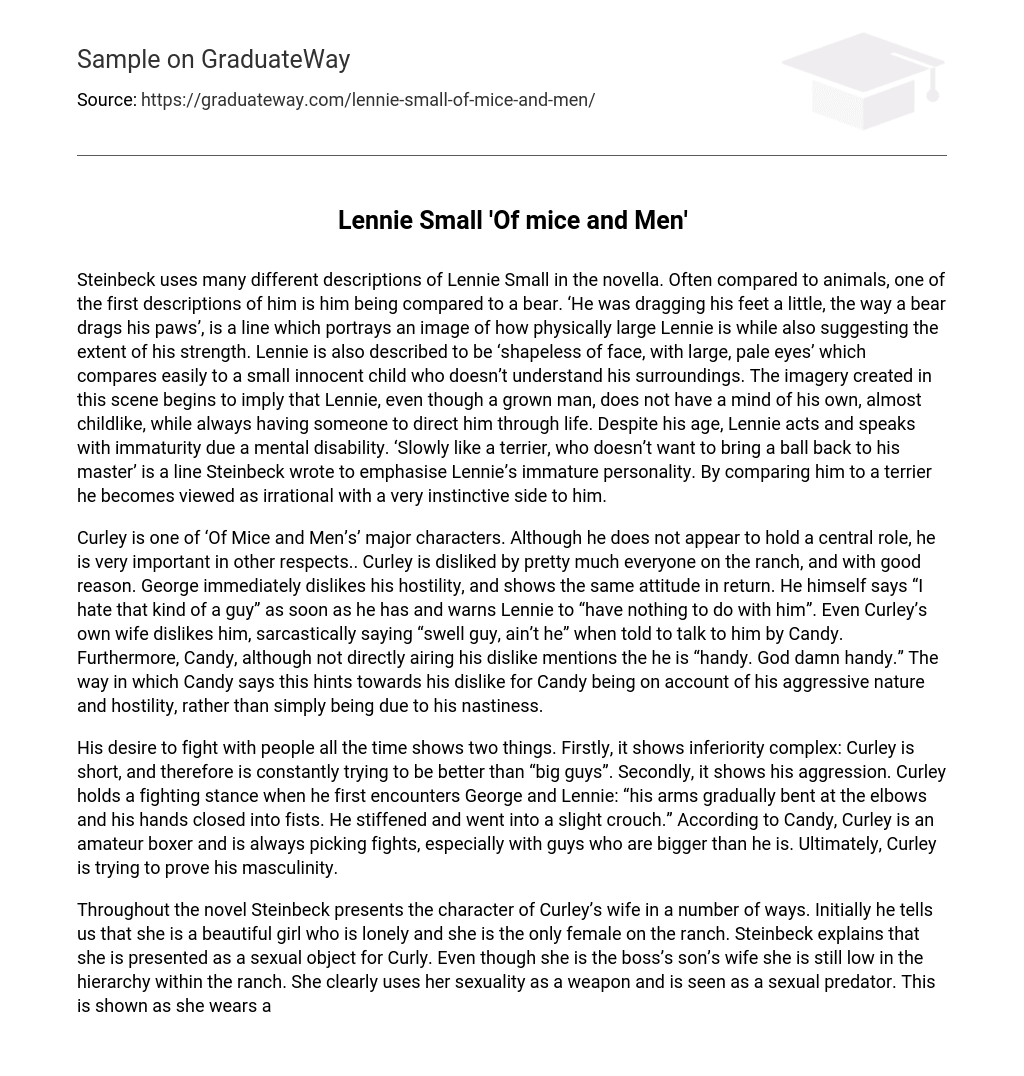In the novella, Steinbeck employs various descriptions to depict Lennie Small. Comparisons to animals are prevalent throughout the text, as seen in one of the initial depictions of Lennie as a bear. The line, ‘He was dragging his feet a little, the way a bear drags his paws’, not only emphasizes Lennie’s physical size but also implies his immense strength. With a ‘shapeless’ face and large, pale eyes, Lennie resembles an innocent child who lacks understanding of his surroundings. This imagery suggests that despite his adult age, Lennie lacks independent thinking and behaves childishly, always relying on someone to guide him through life. In spite of his maturity, Lennie’s actions and speech display immaturity due to his mental disability. Steinbeck highlights this aspect by stating, ‘Slowly like a terrier, who doesn’t want to bring a ball back to his master’, painting Lennie as irrational and driven by instinct, likening him to a terrier.
Curley is a significant character in ‘Of Mice and Men’, despite not having a central role. He is widely disliked by everyone on the ranch for valid reasons. George immediately takes a disliking to his hostility and reciprocates the same attitude. George even warns Lennie to stay away from Curley, stating “I hate that kind of a guy.” Even Curley’s wife sarcastically remarks “swell guy, ain’t he” when told to speak to him by Candy. Additionally, Candy indirectly expresses his dislike for Curley, noting that he is “handy. God damn handy.” This suggests that Candy dislikes Curley not only because of his unpleasantness, but also due to his aggressive nature and hostility.
The text depicts two aspects of Curley’s personality that stem from his constant desire to engage in confrontations with others. Firstly, this behavior reveals his inferiority complex, as Curley’s short stature fuels his constant need to prove himself against taller individuals. Additionally, his aggression is evident as he assumes a fighting stance upon encountering George and Lennie, with his arms bending at the elbows and hands clenched into fists. According to Candy, Curley frequently initiates fights, particularly with those who are physically larger than him, suggesting his inclination to assert his masculinity.
In the novel, Steinbeck presents Curley’s wife in multiple ways. Initially, she is portrayed as a beautiful and lonely girl who is the sole woman on the ranch. Despite being married to the boss’s son, she holds a low position within the hierarchy of the ranch. It becomes apparent that she utilizes her sexuality as a weapon and is viewed as a sexual predator, evident from her choice of attire like wearing red garments and ostrich feathers. The color red symbolizes love, danger, and sex. Unfortunately, her sexuality lacks influence on the farm due to everyone’s fear of facing consequences from her influential husband. She employs flirtation as a strategy to gain entry into the stable and engage socially with men while frequently inquiring about Curley’s whereabouts as a distraction.
Steinbeck portrays Curley’s wife in a negative light, almost as if she is a sex slave. This negative image of her is reinforced by the way other characters describe her. George refers to her as a ‘rattrap and a tramp’, Lennie calls her ‘purdy’, and Candy implies that she is sexually promiscuous with his comment about the Vaseline-filled glove. Despite being seen as an object of sexual desire, men are cautious around her and try to avoid contact. Curley’s wife uses her appearance to exploit the weaknesses of others for her own protection or survival. She deliberately presents herself in a sexually appealing way, with full red lips, heavily made-up eyes, and clustered hair. Her choice of clothing is feminine and alluring, aiming to be admired and noticed. Her actions and mannerisms also have a sexual undertone, like when she leans against the door frame provocatively. Steinbeck portrays her as a tease and an object of desire.





